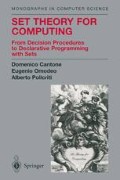Abstract
This chapter provides many examples of how set theory is used to specify problems and algorithms and to characterize precisely domains formed by mathematical entities (e.g., numeric fields) or formed by algorithmic data structures (e.g., by trees).
Access this chapter
Tax calculation will be finalised at checkout
Purchases are for personal use only
Preview
Unable to display preview. Download preview PDF.
Author information
Authors and Affiliations
Rights and permissions
Copyright information
© 2001 Springer Science+Business Media New York
About this chapter
Cite this chapter
Cantone, D., Omodeo, E., Policriti, A. (2001). Sets for Problem Solving. In: Set Theory for Computing. Monographs in Computer Science. Springer, New York, NY. https://doi.org/10.1007/978-1-4757-3452-2_5
Download citation
DOI: https://doi.org/10.1007/978-1-4757-3452-2_5
Publisher Name: Springer, New York, NY
Print ISBN: 978-1-4419-2905-1
Online ISBN: 978-1-4757-3452-2
eBook Packages: Springer Book Archive

